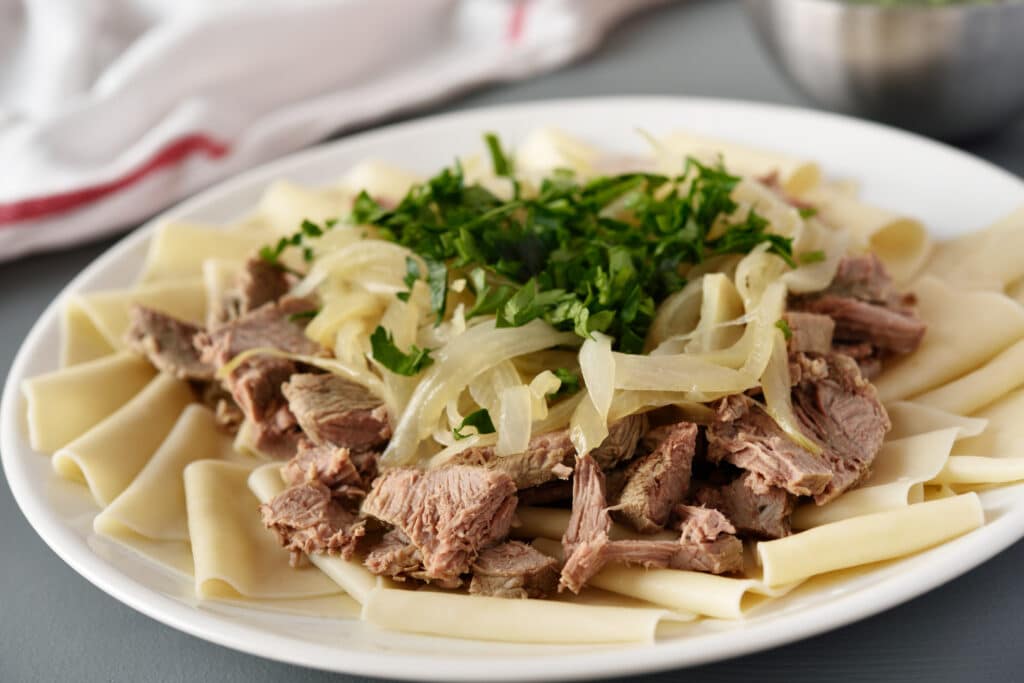Beshbarmak, a dish deeply rooted in the culinary traditions of Kyrgyzstan, is more than just food. It’s a symbol of hospitality, unity, and cultural identity.
This hearty meal, often shared among family and friends during special occasions or gatherings, has a rich history that reflects the nomadic lifestyle of the Kyrgyz people.
Our team at Remitly created this guide as part of our series that celebrates the traditional foods of our global customers. Recipe included!
The Origin of Beshbarmak
The name “Beshbarmak” translates to “five fingers,” indicating that this dish was traditionally eaten with hands. Its origins trace back to the nomadic tribes of Central Asia who needed hearty meals to sustain their strenuous lifestyle.
Over time, Beshbarmak evolved from a survival necessity into a cherished tradition.
Today, it’s not only one of the favorite dishes of locals, it is also consumed in neighboring countries, and ppreciated by visitors seeking an authentic taste of Kyrgyz culture.

Ingredients Used in Beshbarmak
The main ingredients in Beshbarmak are meat and noodles. Traditionally, horse meat or mutton is used; however, beef or chicken can also be substituted depending on personal preference or availability. The noodles are homemade and rolled out into thin sheets before being cut into small squares.
Vegetables such as onions and carrots are often added for flavor while spices like black pepper and bay leaves enhance the taste further.
Recipe for Beshbarmak
Beshbarmak is a dish that’s as enjoyable to prepare as it is to eat. Here’s a simple recipe you can follow to make your own version of this traditional Kyrgyz meal.
Ingredients
- 1 kg of meat (horse, mutton, beef or chicken)
- 300 grams of flour
- 2 large onions
- 2 carrots
- Salt and black pepper to taste
- Bay leaves (optional)
Instructions
- Start by boiling the meat in a large pot filled with water. Add one chopped onion, carrots, salt, pepper and bay leaves if using. Cook until the meat is tender.
- While the meat is cooking, prepare the noodles. Mix flour with water and knead into a firm dough. Roll out the dough into thin sheets and cut into small squares.
- Once the meat is cooked, remove it from the pot and set aside. Keep the broth simmering.
- Boil the noodles in this broth until they’re cooked through.
- Drain the noodles and arrange them on a large platter. Place the cooked meat on top of these noodles.
- Serve hot with remaining broth on the side as soup.
Remember that Beshbarmak is best enjoyed when shared with others!
Variations of Beshbarmak Across Kyrgyzstan
While Beshbarmak remains a staple across Kyrgyzstan, regional variations do exist. Some regions prefer to use different types of meat or add additional ingredients like potatoes or bell peppers. Others might alter the shape or size of the noodles.
Despite these variations, the essence of Beshbarmak remains consistent – it’s a communal dish meant to be shared and enjoyed together. This common thread ties all versions of Beshbarmak together, making it a unifying symbol of Kyrgyz culture.
Kyrgyz Cuisine: A Blend of Traditions
Kyrgyz cuisine reflects its nomadic history and geographical location at crossroads of several cultures. It’s characterized by hearty meals designed to sustain harsh climates and strenuous lifestyles.
Meat Dishes
Meat plays an integral role in Kyrgyz cuisine due to its nomadic roots where livestock was readily available source of food. Apart from Beshbarmak, other popular dishes include Shashlik (skewered grilled meat) and Kuurdak (a stew made from various organ meats).
Dairy Products
Dairy products are also a staple in Kyrgyz diet. Kumis, a fermented mare’s milk, is a traditional drink often consumed during summer months. Other dairy products include sour cream, butter and various types of cheese.
Bread and Pastries
Bread holds a special place in Kyrgyz culture. It’s often served at every meal and considered sacred. Tandyr nan, a type of flatbread baked in clay ovens, is particularly popular.
Pastries like Samsa (stuffed with meat or vegetables) and Chuchvara (dumplings similar to Russian pelmeni) are also common.
Fruits and Vegetables
While meat dominates the cuisine, fruits and vegetables are not overlooked. They’re often used in salads or as accompaniments to main dishes. Apples, apricots, plums, tomatoes, cucumbers and cabbage are commonly consumed.
Kyrgyz cuisine offers an intriguing blend of flavors that reflect its rich history and diverse influences. Whether it’s the communal Beshbarmak or the refreshing Kumis, each dish tells a story about the people and their way of life.
Visit the homepage, download our app, or check out our Help Center to get started.